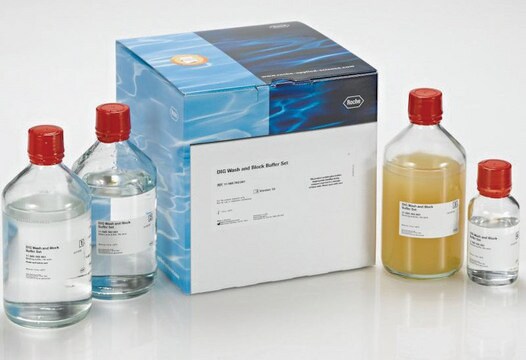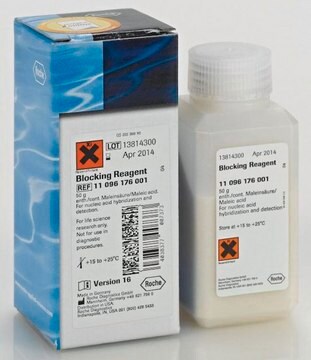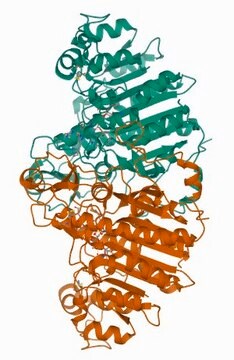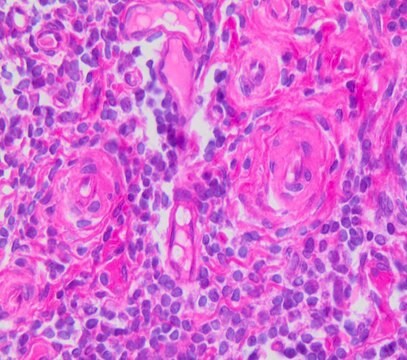PF092
Fas Ligand Plus, Human, Recombinant
Fas Ligand Plus, Human, Recombinant, consists of amino acids 103-281 fused to a 26-amino acid linker and FLAG®-tag at the N-terminus and expressed in HEK293 cells.
Anmeldenzur Ansicht organisationsspezifischer und vertraglich vereinbarter Preise
Alle Fotos(1)
About This Item
UNSPSC-Code:
12352202
NACRES:
NA.77
Empfohlene Produkte
Rekombinant
expressed in HEK 293 cells
Qualitätsniveau
Assay
≥95% (SDS-PAGE)
Form
lyophilized
Hersteller/Markenname
Calbiochem®
Lagerbedingungen
OK to freeze
avoid repeated freeze/thaw cycles
Versandbedingung
wet ice
Lagertemp.
−20°C
Allgemeine Beschreibung
Recombinant, human Fas ligand (amino acids 103-281) fused to a 26-amino acid linker and FLAG®-tag at the N-terminus and expressed in HEK293 cells. Does not require enhancer for activity. Suitable for cytotoxicity assays. M.W. 32,000 - 35,000.
Recombinant, human Fas ligand (amino acids 103-281) fused to a 26-amino acid linker and FLAG®-tag at the N-terminus and expressed in HEK293 cells. Glycosylation of recombinant human sFasL is similar or identical to natural human FasL. The molecular weight is ~32 kDa (nonglycosylated) and ~37-42 kDa (glycosylated) by SDS-PAGE under reducing conditions. The recombinant protein is produced in HEK293 cells. It does not require enhancer for activity. Useful for cytotoxicity assays.
Fas Ligand (FasL/APO-1L/CD95L) is a ~37-42 kDa type II transmembrane protein belonging to the TNF family. Interaction between FasL and Fas induces apoptosis of Fas-sensitive cells. FasL is implicated in CTL-mediated-killing, activation-induced cell death, creation of immune-privileged sites and tissue homeostasis. The extracellular domain of human FasL can be cleaved off by a metalloprotease, generating soluble FasL (sFasL). Circulating sFasL can be detected in serum of patients with melanoma and certain types of lymphoma.
Fas Ligand (FasL/APO-1L/CD95L) is a ~37-42 kDa type II transmembrane protein belonging to the TNF family. Interaction between FasL and Fas induces apoptosis of Fas-sensitive cells. FasL is implicated in CTL-mediated-killing, activation-induced cell death, creation of immune-privileged sites and tissue homeostasis. The extracellular domain of human FasL can be cleaved off by a metalloprotease, generating soluble FasL (sFasL). Circulating sFasL can be detected in serum of patients with melanoma and certain types of lymphoma.
Biochem./physiol. Wirkung
≥1 ng/ml kills Fas-sensitive cells
Warnhinweis
Toxicity: Standard Handling (A)
Physikalische Form
Lyophilized from PBS.
Rekonstituierung
Following reconstitution, aliquot and freeze (-20°C). Stock solutions are stable for up to 3 months at -20°C.
Reconstitute in 50 µl PBS to yield a final stock concentration of 100 µg/ml. Further dilute in culture medium with 5% FCS immediately prior to use.
Sonstige Hinweise
Ashkenazi, A., and Dixit, V.M. 1998. Science281, 1305.
Nagata, S., 1997 Cell88, 355.
Hahne, M., et al. 1996. Science274, 1363.
Bellgrau, D., et al. 1995. Nature377, 630.
Lowin, B., et al. 1994. Nature370, 650.
Russell, J.H., et al. 1993. Proc. Natl. Acad. Sci. USA90, 4409.
Nagata, S., 1997 Cell88, 355.
Hahne, M., et al. 1996. Science274, 1363.
Bellgrau, D., et al. 1995. Nature377, 630.
Lowin, B., et al. 1994. Nature370, 650.
Russell, J.H., et al. 1993. Proc. Natl. Acad. Sci. USA90, 4409.
Glycosylation of recombinant human sFasL is similar or identical to natural human FasL. The molecular weight is ~32 kDa (nonglycosylated) and ~35 kDa (glycosylated) by SDS-PAGE under reducing conditions. The recombinant protein is produced in HEK293 cells. It does not require enhancer for activity.
Rechtliche Hinweise
CALBIOCHEM is a registered trademark of Merck KGaA, Darmstadt, Germany
FLAG is a registered trademark of Merck KGaA, Darmstadt, Germany
Lagerklassenschlüssel
11 - Combustible Solids
WGK
WGK 1
Flammpunkt (°F)
Not applicable
Flammpunkt (°C)
Not applicable
Analysenzertifikate (COA)
Suchen Sie nach Analysenzertifikate (COA), indem Sie die Lot-/Chargennummer des Produkts eingeben. Lot- und Chargennummern sind auf dem Produktetikett hinter den Wörtern ‘Lot’ oder ‘Batch’ (Lot oder Charge) zu finden.
Besitzen Sie dieses Produkt bereits?
In der Dokumentenbibliothek finden Sie die Dokumentation zu den Produkten, die Sie kürzlich erworben haben.
Unser Team von Wissenschaftlern verfügt über Erfahrung in allen Forschungsbereichen einschließlich Life Science, Materialwissenschaften, chemischer Synthese, Chromatographie, Analytik und vielen mehr..
Setzen Sie sich mit dem technischen Dienst in Verbindung.








